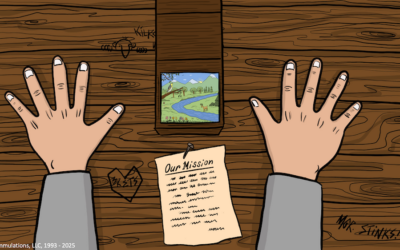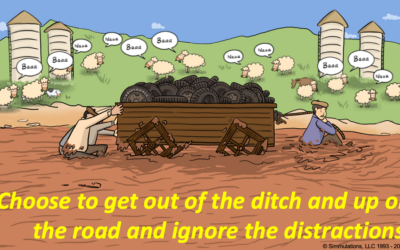Are people Quiet Quitters or just “UN-engaged?”
And what pushes so many to make those choices to un-engage?
Personal engagement IS a choice people make related to balance of perceived workplace consequences. Since so many ARE un-engaged, it is certainly related to how they are being managed. This seems evident. And we can do things differently to improve our leadership.
Perhaps the very first sentence, above, might clang with self-descriptions and beliefs but I ask the question because SOME of us (and, apparently, many of us) are choosing to be un-involved and un-engaged in our workplaces. So, one question is around what we can do about this as managers and human resource professionals.
A staggering 85% of employees globally are not actively engaged, according to Gallup’s “State of the Global Workplace 2024” report.
I very much dislike the term, “Quiet Quitter” as I feel it doesn’t align well with the reality of what is happening in the workplace. And, I find the label “quiet quitter” to not be very useful because it is pretty negative. After all, who wants to be know as a Quitter? And thinking about those un-involved people as quitting is such a negative framework, unlikely to help produce a positive supporting framework for change.
If you were told that you were a Quiet Quitter, what would you feel that says about you? How would you feel about being so-labeled?
AI Definition of a Quitter: A quitter is someone who gives up easily in the face of difficulty or challenge. Other descriptive words for quitter are Defeatist, Deserter, Dropout and Shirker. Based on this definition, does this really describes the 25% of the people at the top of the “Quiet Quitter Disengagement Curve?”
Coaster!
A better descriptor could be “Coaster.” A Coaster would be described as:
- Going with the flow: This implies a lack of initiative but not necessarily negativity.
- Taking it easy: This suggests someone is relaxed and not pushing themselves and not feeling challenged.
- Maintaining the status quo: This describes someone who avoids change and prefers to keep things as they are because there are few pressures.
Unmotivated, complacent and certainly underachieving are also good words for Coasters.
I would much rather that we would choose to use the word “Coaster” to describe the majority of the disengaged and uninvolved people. After all, we really did not HIRE bad people when we put them through our selection process, right? Maybe they feel we did something to them…
I asked Gemini to explain the differences between those quitters and those who are actively unengaged making only a few edits to its description:
The term “quiet quitters” is used as a catch-all phrase, and it doesn’t ever perfectly encompass actively unengaged people. Here’s a breakdown:
-
Quiet quitters: Typically refer to employees who meet expectations and complete their assigned tasks but don’t go above and beyond. They might be psychologically unattached to their work and not very enthusiastic, yet they fulfill their basic obligations.
-
Actively un-engaged: This describes employees who are clearly unhappy and disengaged with their work. They might show this through behaviors like missed deadlines, poor quality work, negativity towards colleagues, or actively looking for a new job.
- The Coasters: People who are simply choosing to flow along and not disrupt their work reality. They are “okay” with how things are and not choosing to actively resist management but also not likely to volunteer to teams to try to make a difference. They are observers and not active participants. But, if actively involved, they can be engaged.
Here’s why the terms might overlap but aren’t identical:
- Visibility: Quiet quitters are subtler in their disengagement. Actively unengaged people might be more vocal about their unhappiness.
- Performance: Quiet quitters might still be meeting expectations, while actively unengaged people could be underperforming.
So, quiet quitters are only a subset of actively unengaged people — not all actively unengaged people are quiet quitters.
Here are some other terms that might better describe actively unengaged employees:
- Disgruntled: Expresses dissatisfaction and frustration.
- Checked out: Highlights a lack of motivation or interest.
- Low morale: Indicates a general feeling of negativity and discouragement.
Ultimately, the best way to describe an employee depends on their specific behaviors and level of engagement.
A Short Song on Coasting and Coasters
— Scott’s AI-prompted song-writing
Working at the office, feeling on a slide
Coasting through the motions, no big need to hide
Boss man gives the orders, but they fall on my deaf ears
Ambition’s on vacation, been gone for many years
(Chorus)
Quiet quitting Coaster, that’s my name,
Won’t rock the boat, won’t take the blame.
No raise, no praise, that’s fine by me
That nice paycheck’s all I see.
(Verse 2)
Meetings and deadlines go in one ear
Out the other ever faster, year after year
Water cooler gossip, doesn’t spark a peep
My social battery’s dead, done gone fast asleep
(Chorus)
Quiet quitting Coaster, that’s my name,
Won’t rock the boat, won’t take the blame.
No raise, no praise, that’s fine by me
That nice paycheck’s all I see.
(Bridge)
Some folks climb the ladder, clawing to the top
But I’m happy as a coaster, my performance doesn’t drop
(Chorus)
Quiet quitting Coaster, that’s my name,
Won’t rock the boat, won’t take the blame.
No raise, no praise, that’s fine by me
That nice paycheck’s all I see.
II wonder how many workers in the workplace see themselves as Coasters and how many are bothered by that. My guess is that most of these people KNOW they could be more productive but they blame it on any number of outside influences. So the challenge of a manager is to discover the potential causes of this lack of motivation and look to do some things to impact those dynamics:
Some Causes of Unengagement:
- Lack of Teamwork and Excessive Competition: Many people simply tire of competition being the driving purpose in a workgroup. They just choose to not compete anymore.
- Lack of Purpose: Only 22% of employees strongly agree their job makes a difference (Gallup 2024). Feeling their work lacks meaning can lead to disengagement.
- Poor Communication: Gallup identifies poor communication as the number one complaint contributing to disengagement. Employees who feel uninformed are less likely to be invested.
- Limited Growth Opportunities: A lack of career development opportunities can leave employees feeling stagnant and unchallenged.
- Feeling Unsafe at Work: Arbinger Institute’s research highlights the concept of psychological safety. When employees don’t feel safe taking risks or voicing concerns, engagement suffers.
- Managerial Disconnect: Gallup reports that 70% of the variance in team engagement is explained by the manager. Poor leadership and lack of support can significantly impact employee motivation.
- Work-Life Imbalance: The rise of remote and hybrid work models has blurred boundaries. Without clear separation, employees can experience burnout, leading to disengagement.
I won’t make simple real suggestions as to what you do. But the Truth is out there. The key is that we (They and Us) WANT to make the changes and that we see the real opportunities for improvement and impact.
I’ll simply suggest the idea that,
“Nobody ever washes a rental car,”
and that making the environment such that people can become actively involved and have some ownership to personal and organizational improvement, it can make a difference.

We hear about “THEM” all the time, but often they are really made up of “US!”
GOOD team building can help. Consider.
Thoughts?
—
For the FUN of It!
 Dr. Scott Simmerman is a designer of team building games and organization improvement tools.
Dr. Scott Simmerman is a designer of team building games and organization improvement tools.
Managing Partner of Performance Management Company since 1984, he is an experienced presenter and consultant who is trying to retire!! He now lives in Cuenca, Ecuador.
You can reach Scott at scott@squarewheels.com
Learn more about Scott at his LinkedIn site.
Here is a link to a press release about The Search for The Lost Dutchman’s Gold Mine teambuilding exercise and its 30 years of positively impacting people and performance.
Square Wheels® is a registered trademark of Performance Management Company
The Search for The Lost Dutchman’s Gold Mine is a trademark of Performance Management Company
Square Wheels images © Performance Management Company, 1993 – 2023. All rights reserved.





0 Comments